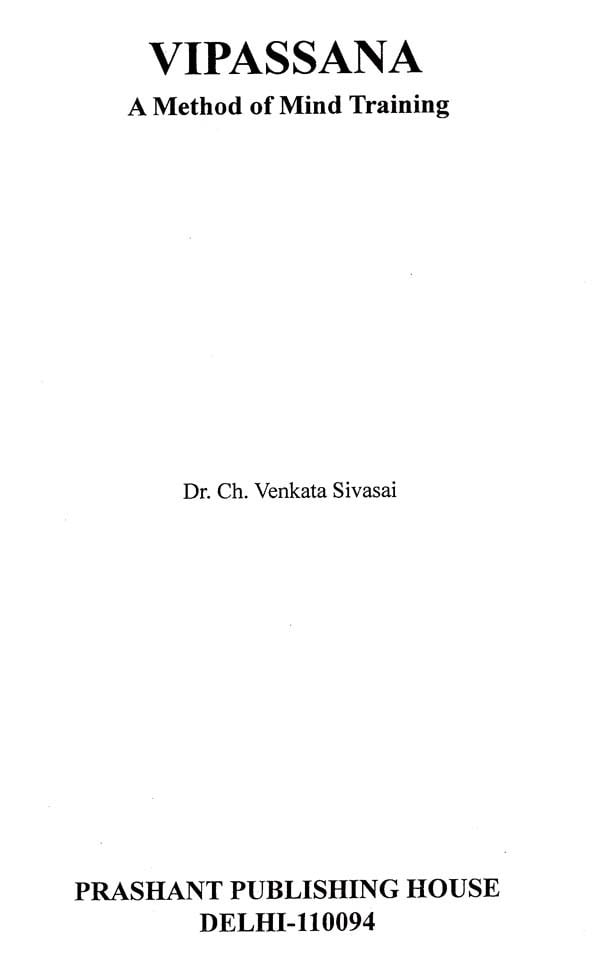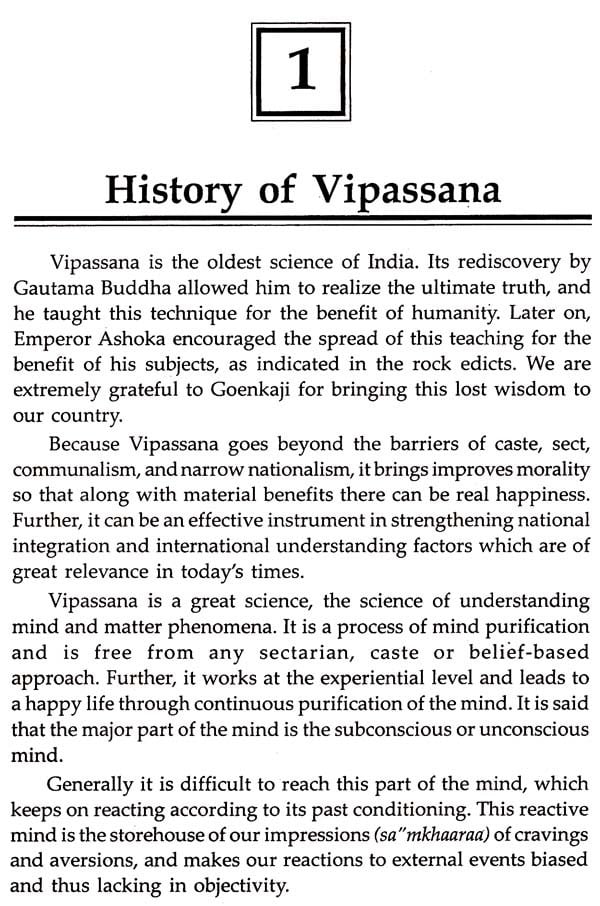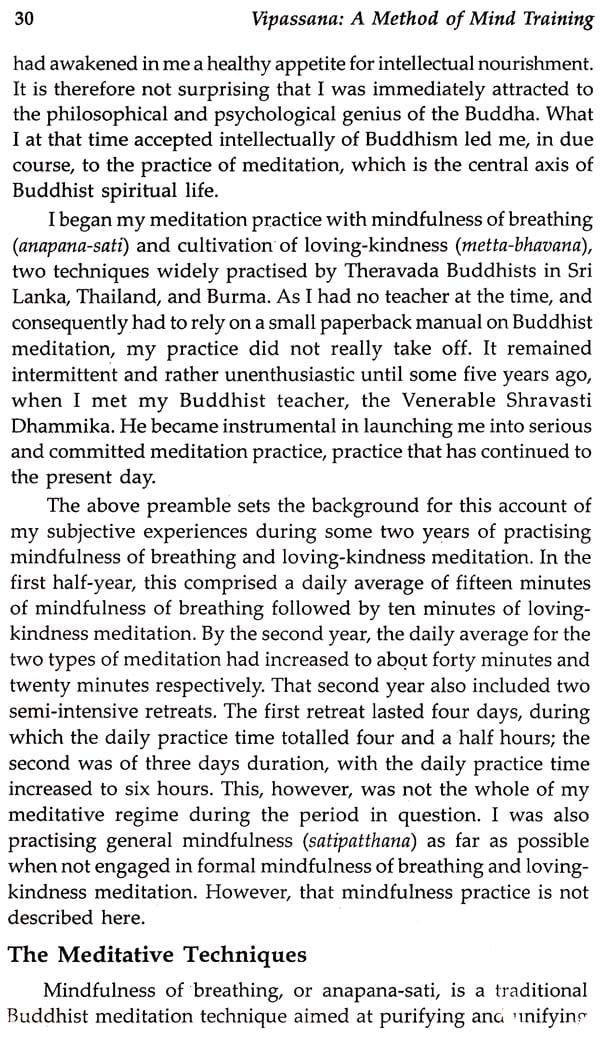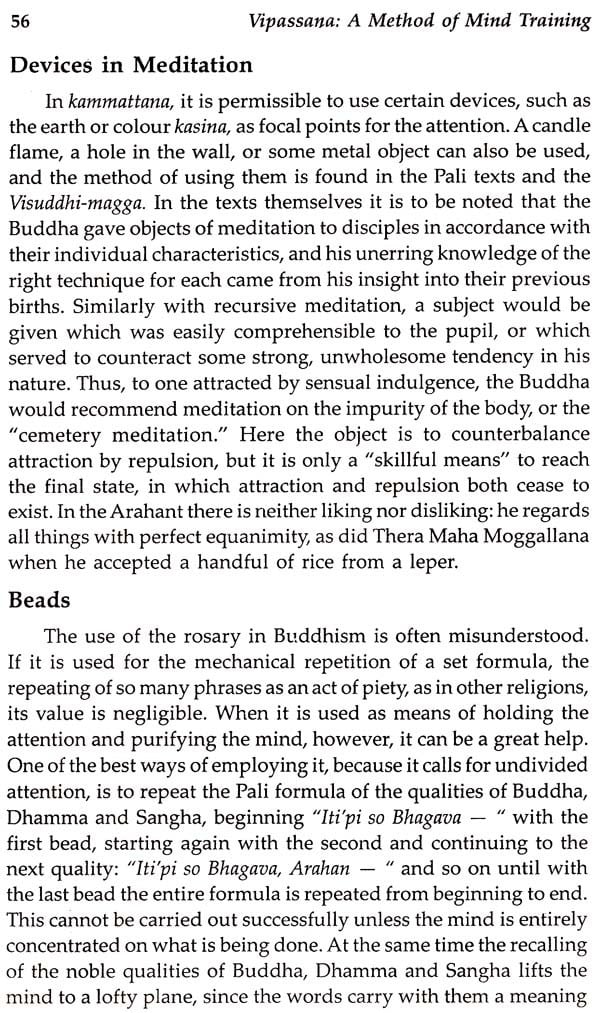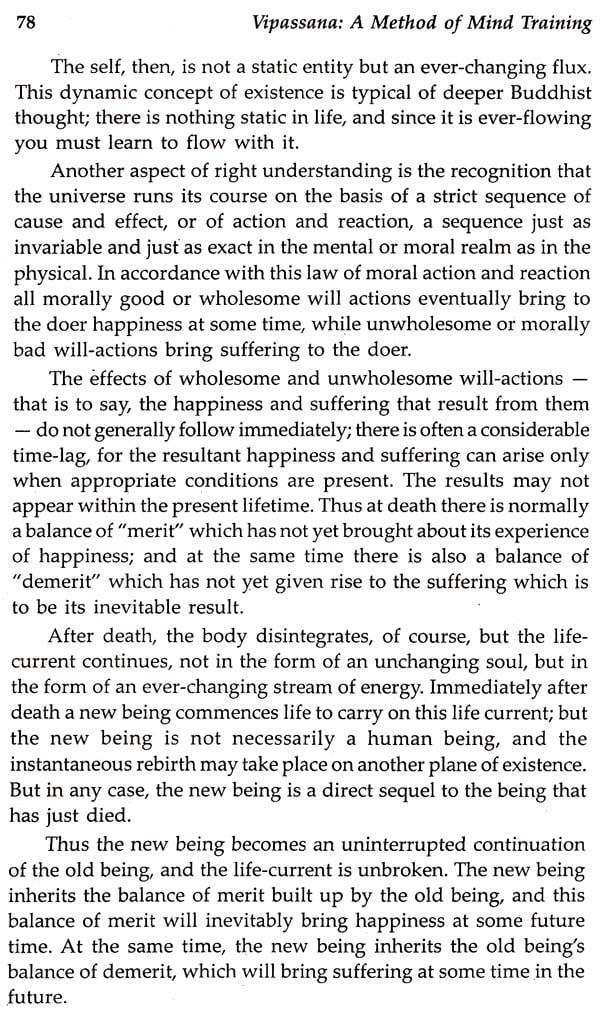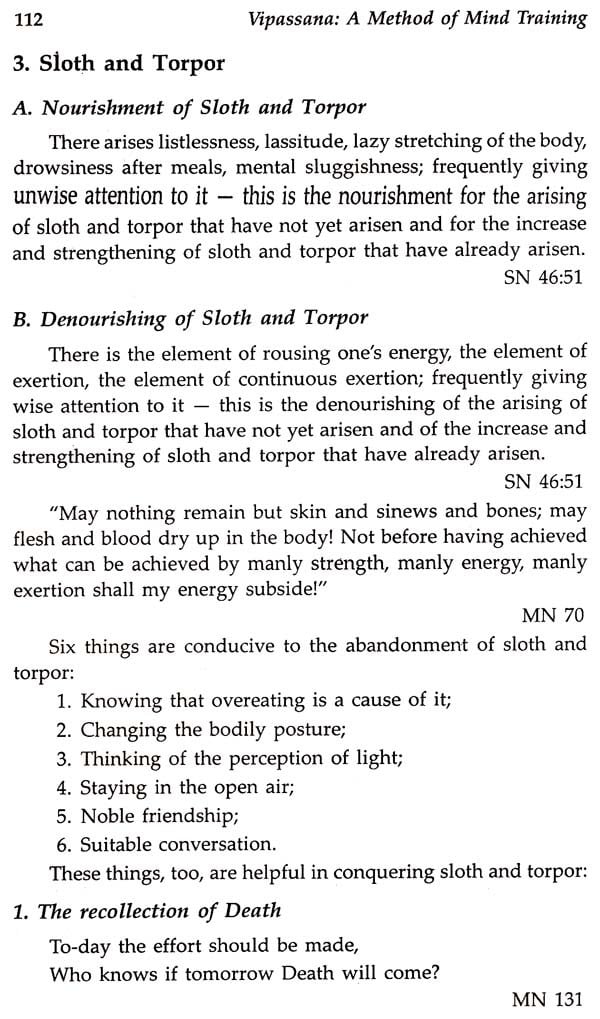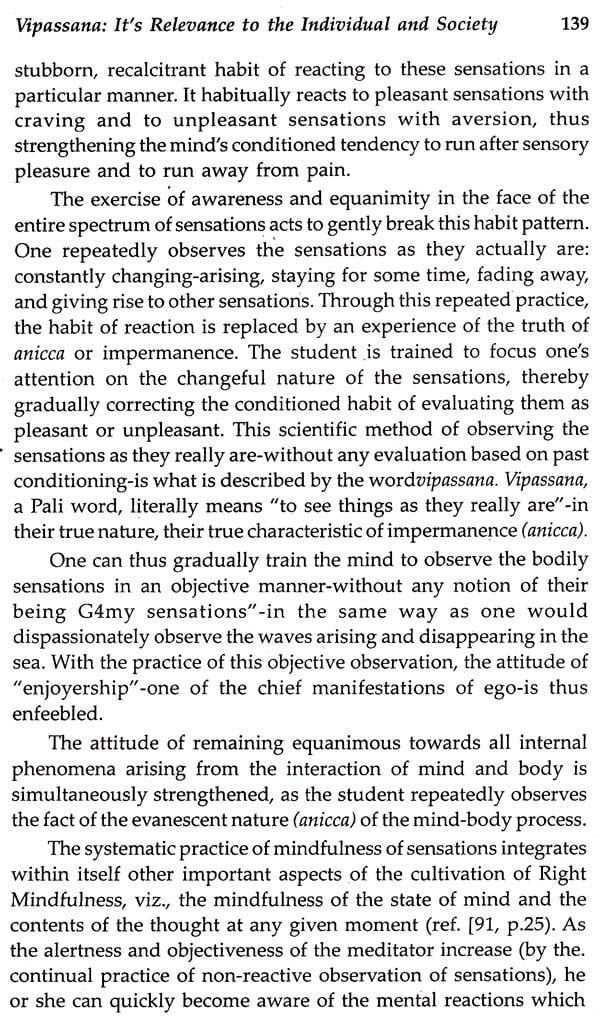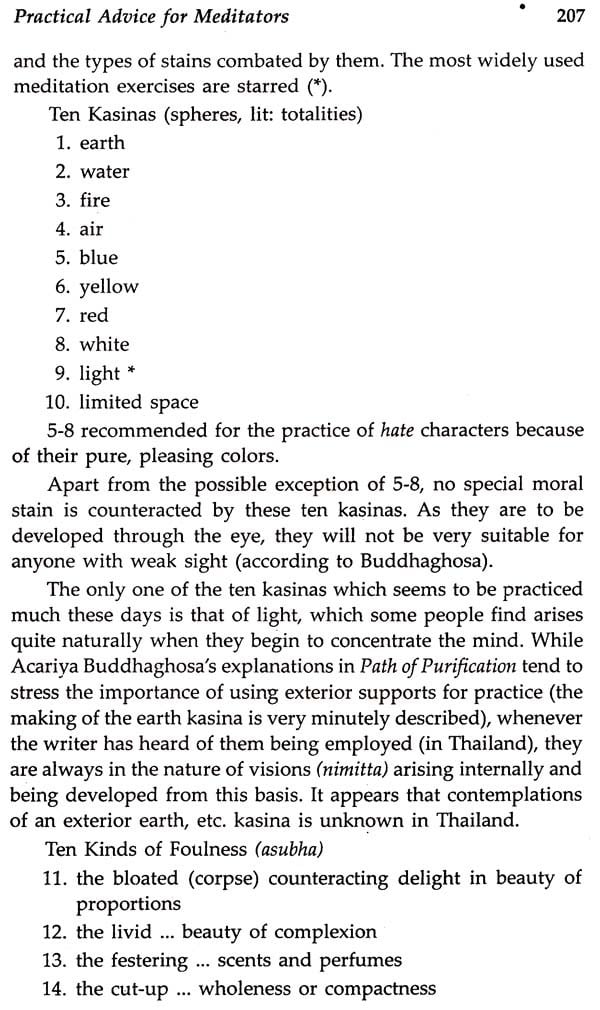
Vipassana- A Method of Mind Training
Book Specification
| Item Code: | UAR301 |
| Author: | Ch. Venkata Sivasai |
| Publisher: | Prashant Publishing House, Delhi |
| Language: | English |
| Edition: | 2015 |
| ISBN: | 9789380565620 |
| Pages: | 224 |
| Cover: | HARDCOVER |
| Other Details | 9.00 X 6.00 inch |
| Weight | 390 gm |
Book Description
Modern life is moving at such a rapid pace that there is no time even to breathe. Our fiercely competitive world is like a rat-race where, in spite of all the technological and economic improvements and multifarious pleasures, people are still unhappy, Humankind has made tremendous progress in the fields of science, industry, and political systems, etc., resulting in materialistic development. Man is the promoter and consumer of these advancements, which aim at improving our standard of living and total well-being.
Every society is made up of individuals. The individual in a modern society is a victim of varying degrees of stresses and strains. His or her existence is full of constant conflict between the world within and the world outside. The materialistic world holds humans under a hypnotic spell. Engaged all the time in filling their stomachs by earning and spending money, people are slaves of their own cravings, euphemistically called ambition, aspiration, aims or ideals. These, alas, are seldom fulfilled, which causes deep distress, frustration and dissatisfaction, whether one belongs to the "Haves" or the "Havenots”. Suffering, then, is a common problem of humanity. It is a universal disease, not the bane of any one nation, or persons of any particular colour or creed. So the remedy must also be universal. Vipassana offers such a remedy.
The basis of any healthy, harmonious society is always the healthy, harmonious individual. Only if each individual has a pure, peaceful mind can we expect peace and harmony in the society. Vipassana is a unique technique for obtaining peace and harmony within an individual at the experiential level. The great sage of India, Gautama the Buddha, discovered, or rather rediscovered this technique through his deep meditation. He attained enlightenment through this technique and was liberated from all the defilements of the mind. Then with great compassion and love, he distributed it to the suffering mankind. He did not establish any "ism" or "cult." He taught Vipassana, a way to purify the mind of its negativities of craving and aversion.
Dr. Ch. Venkata Sivasai is presently working as Assistant Professor in School Of Buddhist Studies and Civilization, Gautama Buddha University. Greater Noida, in Utter Pradesh. .He has 17 years of teaching experience for P.G, M.Phil, and PhD students. He has published more than 80 Research papers in various National and International reputed Journals. He has been presenting more than 80 papers in various National and international seminars. He has published 7 books. In his Guidance 7 M.Phils are awarded and 4 Ph.Ds are pursuing. Previously he worked as Associate Professor, Principal, Head of the Department in various Colleges and Universities. He has completed his M.A. M.Phil, and PhD from University of Hyderabad. He also had done M.Sc (Psychology) M.A (Education), M.A (Sanskrit). He worked as Translator for Speeches of Honorable His Holiness Dalai lama in Kalachakra 2006 at Amravati (A.P). His Specializations are Buddhist Ethics, Buddhist Philosophy, Buddhist Psychology, Buddhist Education, Social Engaged Buddhism, Bio-ethics, Engineering Ethics, Human Values and Society. He is Life member in Indian Philosophical Congress and Indian Society for Buddhist Studies. He acted as Chair person for many Technical Sessions in Various National and International Conferences. He got Gold Medal for PhD. He visited Vietnam, Thailand, Srilanka etc.
Vipassana is the oldest science of India. Its rediscovery by Gautama Buddha allowed him to realize the ultimate truth, and he taught this technique for the benefit of humanity. Later on, Emperor Ashoka encouraged the spread of this teaching for the benefit of his subjects, as indicated in the rock edicts. Vipassana goes beyond the barriers of caste, sect, communalism, and narrow nationalism, it brings improves morality so that along with material benefits there can be real happiness. Further, it can be an effective instrument in strengthening national integration and international understanding factors which are of great relevance in today's times.
Vipassana is a great science, the science of understanding mind and matter phenomena. It is a process of mind purification and is free from any sectarian, caste or belief-based approach. Further, it works at the experiential level and leads to a happy life through continuous purification of the mind. It is said that the major part of the mind is the subconscious or unconscious mind. Generally it is difficult to reach this part of the mind, which keeps on reacting according to its past conditioning. Vipassana helps in breaking the barrier between the conscious and unconscious mind. Through the process of observing without reacting, the mind is cleansed of its negativities. With the technique of Vipassana, one reaches deep down to the unconscious level of the mind and experiences sensations within the framework of the body without reacting to them. The law of nature is such that whatever actions we perform are stored in the form of its effect in the unconscious part of the mind.
Need for Meditation: Where exactly does meditation come into the picture? To get an answer, we have to look to more industrialized countries such as the United States and Germany. The nature of the societies produced by advanced. industrialization has been characterized by heavy alcohol, drug and cigarette consumption; pandemic divorces and broken families; economic recession and job insecurities; and strong feelings of competition and frustration leading to heart attacks, suicide and so on.
**Contents and Sample Pages**
